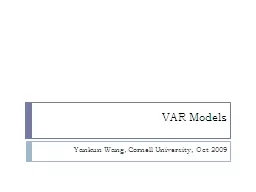

Yankun Wang Cornell University Oct 2009 What is VAR A var p model is with and Originally proposed by Sims 1980 Efficient way of summarizing information contained in the data ID: 276565
Download Presentation The PPT/PDF document "VAR Models" is the property of its rightful owner. Permission is granted to download and print the materials on this web site for personal, non-commercial use only, and to display it on your personal computer provided you do not modify the materials and that you retain all copyright notices contained in the materials. By downloading content from our website, you accept the terms of this agreement.
Slide1
VAR Models
Yankun
Wang, Cornell University, Oct 2009Slide2
What is VAR?
A
var
(p) model is: with andOriginally proposed by Sims (1980)Efficient way of summarizing information contained in the dataUseful for forecastingConduct economically interesting analysis under meaningful identification restrictionsSlide3
Outline:
Reduced form VAR
Wold
TheoremSpecificationEstimationPresentation of ResultsStructural VAR
IdentificationPotential extension to “Evaluation of Currency Regimes: the Unique Role of Sudden Stops”by
Assaf Razin and Yona RubinsteinSlide4
The Wold
Theorem
Wold
Theorem: Every stationary process can be written as the sum of two components: a deterministic part and an MA(∞) part.As a result:
Every stationary process can be written as a VAR process of infinite order. Potential Problem:
In reality, we can only deal with finite order. Slide5
Specification
What is the appropriate lag length in the VAR?
Three criterions:
Akaike information criterion (AIC)Schwarz criterion (SIC)Hannan-Quinn criterion (HQC)
( all functions of m, T, and variance-covariance matrix)In practice: Fix an upper bound of lag length q (12), choose the q which minimizes one of the information criterionAIC is inconsistent
For T>20, SIC and HQC will always choose smaller models than AICSlide6
Estimation
Multivariate GLS estimates are the same as equation by equation OLS estimates.
For unrestricted VAR models: ML estimates and equation by equation OLS estimates coincide.
When a VAR is estimated under some restrictions, ML estimates are different from OLS estimates; ML estimates are consistent and efficient if the restrictions are true. Slide7
Presentation of Results
It is rare to report estimated VAR coefficients.
Instead:
Impulse responsesForecast error variance decomposition: assess the relative contribution of different shocks to fluctuations in varablesHistorical Decomposition: given the path of one specific shock, how will the variables evolve?Slide8
Structural VARs
Suppose we have estimated the following reduced form VAR:
with .
! : u is just reduced form residuals, no economic meaning.Solution: Assume , where is the vector of fundamental shocks, then naturally:Lack m(m-1)/2 restrictions to exactly identify D. Slide9
Short-Run Timing Restrictions
Example: Suppose m=3: output, inflation and interest rate:
Criticism: hard to justify from theoretical foundations
In practice: try to switch the ordering the variablesSlide10
Long-run Impact Restrictions
Classical example: Blanchard and
Quah
( 1989)Suppose two variable system: output growth and unemploymentTotal long run impact matrix: Assume: accumulated long-run effect of demand shocks on is zero, Slide11
Sign Restrictions
Restricting the sign (and/or shape) of structural responses.
Faust (1998), Canova and De
Nicolo (2002) and Uhlig(2005)Informally used in research ( e.g. monetary shocks must generate a liquidity effect): this approach makes it explicitMore justifiable by theoretical model: DSGEs seldom deliver all zero restrictions, but lots of sign restrictions usableSlide12
Example:
Uhlig
(2005)
Contractionary Policy: Responses of prices and nonborrowed reserves are not positive and those of the federal funds rate are not negativeSlide13
Razin and Rubinstein:
Output
Growth Rate
Prob
of Sudden Stop/Currency
Crisis
Flexible Exchange Rate Regime
Capital Account Liberalization
-
-
-
+
+Slide14
Could we extend this framework to a dynamic analysis?
What are the variables to include?
[growth rate of output;
change/level of exchange rate regime; change/level of capital account liberalization; probability of crisis]What are the shocks we want to identify? One choice: shocks interpreted according to variablesSlide15
How to Identify the Structural Shocks
?
Shock run restriction?
Long run restriction?Sign restriction?Available convention: Exchange rate shock from flexible to peg should increase crisis probability; Capital Account Liberalization shock from less to more free capital flow should increase crisis probability What are their effects on output?
Slide16Slide17Slide18Slide19Slide20Slide21Slide22